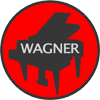In Europe during the Baroque Period, musicians and artists were supported by the church, the state, and the rich. Such a patronage system was the case in Italy for hundreds of years, Including the late 1400s and early 1500s when Michelangelo worked as a sculptor and artist for the Medlci family in Florence. From 1690 until his death Bartolomeo Cristofori (1655-1731) went to work at the court of Prince Ferdinand de' Medici in Florence as a designer and custodian of keyboard Instruments. He Is noted for various innovations in harpsichord construction and especially for the invention of the piano.
Francesco Mannucci noted in his diary (February 1711) that in 1698 Cristofori began work on the "arcicembal che fa il piano e il forte" (harpsichord with soft and loud) The inventory of Medici instruments for 1700 establishes that at least one had been completed by that date. An article by Scipione Maffei In 1711 stated that In 1709 Cristofori had built three "gravicembalo col piano e forte" The unique characteristic of his invention was a mechanical action that made it possible to sound simultaneously as many notes as one had fingers and therefore, to be able to produce any work in the entire literature of Western music with variations of loud and soft according to the player's touch at the keyboard. Cristofori's "piano e forte was a combination of harpsichord shape and power with almost clavichord expressiveness. It Included a complex mechanical action with a hammer that rose towards a string (heavier than a harpsichord string) four times as fast as the key movement (eight times as fast in his later instruments). It also included an escapement to allow the hammer to rebound from the freely vibrating string, a check for the hammer to prevent bouncing, and a shift so the hammer would play only one of the two strings to reduce volume.
Cristofori's "piano e forte" did not generate much enthusiasm In Italy. Harpsichord players found the touch difficult to master and the tone similar, but less brilliant and softer, than the best harpsichords of the day. In the late 1730's Gottfrled Silberman read a German language account of Maffei's article and started experimenting on the new design. Bach tried one of his pianos but did not like the heavy touch and weak treble. Eventually Silberman obtained a more accurate description of Cristofori's action. It is reported that Bach was well pleased with Silberman's latest piano design, which had an action identical to the 1720's Cristofori pianos that survive to this day.
Cristofori and Silberman strived to build a harpsichord with expressive capabilities. The latter half of the 18th Century was dominated by Germans and Austrians concerned with building a louder clavichord. Unfortunately, Cristofori' s design for the action was so complex that subsequent builders greatly simplified It for economy resulting In a less efficient system which was not widely accepted. Later in the 18th Century, developments in action design were really a re-invention of the principles worked out by Cristofori , the inventor of the piano, a stringed keyboard instrument with mechanically operated rebounding hammers.
Saturday, April 25, 2009
Subscribe to:
Post Comments (Atom)


No comments:
Post a Comment